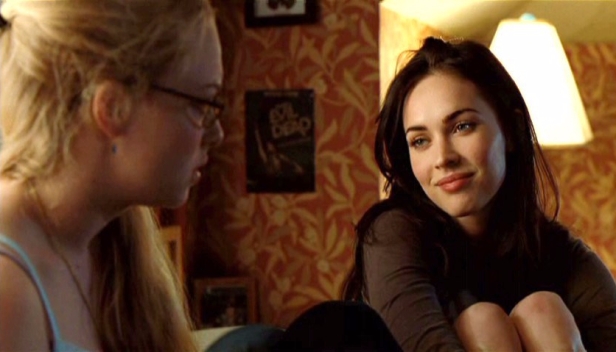Jennifer’s Body was a victim of being marketed the wrong way at the wrong time.
I remember when I first became aware of Karyn Kusama’s 2009 teen girl horror; those TV spots showing Amanda Seyfried and Megan Fox snogging, the lecherous ogling of what looked to be pseudo-lesbian sexuality for the male gaze. Those long takes of Megan Fox walking down school corridors in her cut-off, heart-print hoodie, looking every inch the teen girl sexpot that had long been the darling of creepy male filmmakers everywhere, the evil demon seductress trope out in full, apparently uncritical force.
Because, in 2009, that’s what sold in terms of horror. And, to be fair, it’s what sold the movie to me, a desperately closeted teenager who had only the most normal interest in seeing two beautiful women kissing, thank you very much (and, to this day, Megan Fox remains one of my most beloved bisexual icons, and Amanda Seyfried one of my most feral and unhinged celebrity crushes). But Jennifer’s Body is none of the things it was marketed as. No, it’s so much better than that.
There are so many aspects of this movie I could deep-dive into (and maybe will, in future) but there’s one that always stood out to me the most, especially as I’ve sat with the movie as I’ve aged out of teenager-dom and into adulthood. Written by Diablo Cody fresh off the success of her Oscar-winning Juno script, Jennifer’s Body has, since it’s release, rightly earned a place amongst some of the most beloved women-centric horror of all time. And I think the reason for that is the way it so incisively explores the odd best-friendships that often form between teenage girls. Teen girl horror is a rich well that plenty of filmmakers have come back to with extraordinary success, but none have captured the unique, all-consuming, destructive, obsessive mega-mess of teen girl friendship like Jennifer’s Body.
Needy (Seyfried) and Jennifer (Fox) and their relationship are at the centre of this movie, their dalliances with men, whether sexual, romantic, or cannibalistic, almost comically sidelined; the movie’s most iconic line serves as a reminder of this, when Jennifer assures needy she’s not killing people – “only killing boys.”. Kusama and Cody go out of their way to push those usually-dominant narratives of men’s influence on women’s lives to the side, and instead, focus on the endlessly rich and nuanced well of female friendship during adolescence.
And there’s enough for a damn psychological conference on this relationship. Teenager-dom is a time of ridiculously heightened emotion and, for a lot of people, the beginnings of their sexual development, and Needy and Jennifer take this to the horror-genre-appropriate extreme: sliding between romantic, sexual, antagonistic, intimate, obsessive, and downright violent, it’s confusing and messy, deliberately so.
For a lot of young women navigating intimacy and closeness for the first time as teenagers, it comes in the form of their relationships with other women. The overlap between intense friendship, actual desire, and this strange, unique kind of pseudo-romance as they carve out the shape of what they what romance to look like for them creates a bond that’s nearly unmatched in its intensity. And, whether or not these relationships end in actual murder, as in Jennifer’s Body, their enormity, impact, and destructiveness are reflected perfectly in the gory, bloody, slaughter-heavy climax of the movie. Even after Jennifer’s death, Needy is still left with some of Jennifer’s powers and the need for revenge; their marks on each other, physical and mental, are indelible, for better or for worse.
Like so many other women, Needy and Jennifer’s most significant relationship in their developmental years isn’t the one they share with a man, but the one they share with each other. Cody’s excellent (though mannered) script captures both the highs and lows of these intense relationships in a way I don’t think many other films have, and it’s that which has stuck with me over the years since it first came out.
Only horror could capture the extremity of the way these emotions often feel – and only Jennifer’s Body could do it as well as it needed to be done.
If you enjoyed this article and want to see more stuff like it, please consider supporting us on Ko-Fi. You can check out more of my work on my personal blog, The Cutprice Guignol!
By Lou MacGregor
(header image via Anatomy of a Scream)
